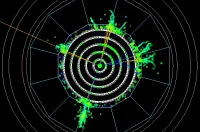 |
 |
|||||||||||||
|
|||||||||||||
|
|||||||||||||
|
RDR meet your other half. A draft version of the Detector Concept Report for the International Linear Collider is now available online. In February, the Global Design Effort published the draft Reference Design Report, providing the first detailed technical snapshot of the accelerator. The DCR completes the picture and makes the physics and detector case for the ILC. “The Detector Concept Report allows the community to form physics goals and wishes for the overall programme,” says DESY's Ties Behnke, an editor for the DCR. “It provides overall guidance for the community on areas where we still need to make progress and sets the stage for the Engineering Design Report.” Four possible detector concepts currently exist for the ILC. In writing the DCR, however, the four different concept groups came together to publish one joint document. “A major goal of this report is to demonstrate the performance of the proposed detector concepts, where, for the first time, we were able to show results based on a very detailed simulation,” says KEK's Akiya Miyamoto, another editor for the DCR. The DCR therefore represents the complete detector and physics community, making it a unique document. “This was a cooperative venture among the detector groups, and it represents the whole community,” says SLAC's John Jaros, also an editor for the DCR. Along the same lines, the report does not go into the details of each individual detector concept. Instead, the DCR provides a status report on the overall technology. Rather than focusing on the requirements for just SiD, for example, the report examines calorimetry as a whole and the range of options that are available. “The report focuses on the technology needed to make this happen,” Behnke says. A final DCR will be published later this summer, on the same timescale as the RDR. In the meantime, the DCR editorial committee seeks feedback from the global community. Comments should be sent to dcrcomment@desy.de. The editors will evaluate all comments at LCWS07 and begin work on a final version of the report. The group will also compile an author list, which will be open to both the machine and detector communities. Once the final DCR is ready, the detector and physics community will focus on developing engineering designs on the same timescale as the Engineering Design Report for the accelerator. “We want to have detector engineering designs and costs ready when the machine EDR comes,” Jaros says. “This is essential to know the scope and the physics capability of the entire project, machine and detector. It won't make sense to go ahead with the ILC until you know you can make detectors that will do the physics.” -- Elizabeth Clements |
|||||||||||||
| © International Linear Collider |
